An Assessment of the Impact of the COVID-19 Pandemic on Consumer Behavior Using the Analytic Hierarchy Process Model
Abstract
:1. Introduction
1.1. Significance of the Study
1.2. Literature Review
1.3. Research Objectives and Hypothesis
2. Materials and Methods
- Unity.
- Complexity.
- Interdependence.
- Hierarchic structure.
- Measurement.
- Consistency.
- Synthesis.
- Tradeoffs.
- Judgement and Consensus.
- Process Repetition.
Modeling the AHP Hierarchical Structure
3. Results and Discussion
4. Conclusions
Author Contributions
Funding
Institutional Review Board Statement
Informed Consent Statement
Data Availability Statement
Conflicts of Interest
References
- World Health Organization. Shortage of Personal Protective Equipment Endangering Health Workers Worldwide; World Health Organization: Geneva, Switzerland, 2020. Available online: https://www.who.int/news/item/03-03-2020-shortage-of-personal-protective-equipment-endangering-health-workers-worldwide (accessed on 2 May 2023).
- Kohli, S.; Timelin, B.; Fabius, V.; Veranen, M.S. How COVID-19 Is Changing Consumer Behavior-Now and Forever. McKinsey & Company. 2020. Available online: https://www.mckinsey.com/~/media/mckinsey/industries/retail/our%20insights/how%20covid%2019%20is%20changing%20consumer%20behavior%20now%20and%20forever/how-covid-19-is-changing-consumer-behaviornow-and-forever.pdf (accessed on 15 June 2023).
- Monitor Deloitte. Impact of COVID-19 on Short- and Medium-Term Consumer Behavior: Will the Crisis Have a Lasting Effect on Consumption? Monitor Deloitte: Cambridge, UK, 2020. Volume 6. Available online: https://www2.deloitte.com/content/dam/Deloitte/sk/Documents/consumer-business/Impact_of_the_COVID-19_crisis_on_consumer_behavior.pdf (accessed on 16 June 2023).
- KPMG International Limited. COVID-19 Is Changing Consumer Behavior Worldwide; Business Needs to Adapt Rapidly; KPMG: London, UK, 2020; Available online: https://kpmg.com/ro/en/home/media/press-releases/2020/12/covid-19-is-changing-consumer-behavior-worldwide---business-need.html (accessed on 20 June 2023).
- Statista. Coronavirus: Impact on the Retail Industry Worldwide-Statistics & Facts; Statista: New York, NY, USA, 2023; Available online: https://www.statista.com/topics/6239/coronavirus-impact-on-the-retail-industry-worldwide/#editorsPicks (accessed on 10 July 2023).
- D’Arpizio, C.; Levato, F.; Fenili, S.; Colacchio, F.; Prete, F. Luxury after COVID-19: Changed for (the) Good? Bain & Company: Boston, MA, USA, 2020. Available online: https://www.bain.com/insights/luxury-after-coronavirus/ (accessed on 9 June 2023).
- Euromonitor International. Top 10 Global Consumer Trends 2022; Euromonitor International: London, UK, 2022; Available online: https://go.euromonitor.com/white-paper-EC-2022-Top-10-Global-Consumer-Trends.html?utm_campaign=CT_WP_20_01_14_Top_10_GCT_2020_EN&utm_medium=Website&utm_source=Landing-Page (accessed on 2 May 2023).
- International Monetary Fund. The Great Lockdown: Worst Economic Downturn Since the Great Depression. Press Release. 2020. Volume 20. Available online: https://www.imf.org/en/News/Articles/2020/03/23/pr2098-imf-managing-director-statement-following-a-g20-ministerial-call-on-the-coronavirus-emergency (accessed on 5 July 2023).
- United Nations. COVID-19 and E-commerce: A Global Review. In Proceedings of the United Nations Conference on Trade and Development, Bridgetown, Barbados, 18–23 October 2020. Available online: https://unctad.org/system/files/official-document/dtlstict2020d13_en.pdf (accessed on 6 July 2023).
- Šostar, M.; Chandrasekharan, H.A.; Rakušić, I. Importance of Nonverbal Communication in Sales. In Proceedings of the 8th International Conference “Vallis Aurea” Focus on: Tourism & Rural Development, Polytechnic in Pozega, DAAM Vienna, Požega, Croatia, 8–10 September 2022; pp. 451–459. Available online: https://www.bib.irb.hr:8443/1262599 (accessed on 10 June 2023).
- Šostar, M.; Ristanović, V. Assessment of Influencing Factors on Consumer Behavior Using the AHP Model. Sustainability 2023, 15, 10341. [Google Scholar] [CrossRef]
- Saaty, T.L. An Eigenvalue Allocation Model for Prioritization and Planning; Working Paper; Energy Management and Policy Center, University of Pennsylvania: Philadelphia, PA, USA, 1972. [Google Scholar]
- Saaty, T.L. A scaling method for priorities in hierarchical structures. J. Math. Psychol. 1977, 15, 234–281. [Google Scholar] [CrossRef]
- Saaty, T.L. The Analytic Hierarchy Process; McGraw-Hill: New York, NY, USA, 1980. [Google Scholar]
- Saaty, T.L. Decision Making for Leaders: The Analytic Hierarchy Process for Decisions in a Complex World; RWS Publications: Pittsburgh, PA, USA, 2008. [Google Scholar]
- Salem, O.; Salman, B.; Ghorai, S. Accelerating Construction of Roadway Bridges Using Alternative Techniques and Procurement Methods. Transport 2017, 33, 567–579. [Google Scholar] [CrossRef]
- Jurík, L.; Horňáková, N.; Šantavá, E.; Cagáňová, D.; Sablik, J. Application of AHP method for project selection in the context of sustainable development. Wirel. Netw. 2020, 28, 893–902. [Google Scholar] [CrossRef]
- Guzal-Dec, D.J.; Zwolińska-Ligaj, M.A. How to Deal with Crisis? Place Attachment as a Factor of Resilience of Urban–Rural Communes in Poland during the COVID-19 Pandemic. Sustainability 2023, 15, 6222. [Google Scholar] [CrossRef]
- Ghodsi, M.; Pourmadadkar, M.; Ardestani, A.; Ghadamgahi, S.; Yang, H. Understanding the Impact of COVID-19 Pandemic on Online Shopping and Travel Behaviour: A Structural Equation Modelling Approach. Sustainability 2022, 14, 13474. [Google Scholar] [CrossRef]
- Sheth, J. Impact of COVID-19 on consumer behavior: Will the old habits return or die? J. Bus. Res. 2020, 117, 280–283. [Google Scholar] [CrossRef] [PubMed]
- Sorrentino, A.; Leone, D.; Caporuscio, A. Changes in the post-COVID-19 consumers’ behaviors and lifestyle in italy. A disaster management perspective. Ital. J. Mark. 2022, 1, 87–106. [Google Scholar] [CrossRef]
- Akhtar, N.; Khan, N.; Mahroof Khan, M.; Ashraf, S.; Hashmi, M.S.; Khan, M.M.; Hishan, S.S. Post-COVID 19 Tourism: Will Digital Tourism Replace Mass Tourism? Sustainability 2021, 13, 5352. [Google Scholar] [CrossRef]
- Kim, R.Y. The Impact of COVID-19 on Consumers: Preparing for Digital Sales in IEEE. Eng. Manag. Rev. 2020, 48, 212–218. [Google Scholar] [CrossRef]
- Gu, S.; Ślusarczyk, B.; Hajizada, S.; Kovalyova, I.; Sakhbieva, A. Impact of the COVID-19 Pandemic on Online Consumer Purchasing Behavior. J. Theor. Appl. Electron. Commer. Res. 2021, 16, 2263–2281. [Google Scholar] [CrossRef]
- Chang, H.H.; Meyerhoefer, D.C. COVID-19 and the Demand for Online Food Shopping Services: Empirical Evidence from Taiwan. Am. J. Agric. Econ. 2020, 103, 448–465. [Google Scholar] [CrossRef]
- Rahmanov, F.; Mursalov, M.; Rosokhata, A. Consumer behavior in digital era: Impact of COVID-19. Mark. Manag. Innov. 2021, 2, 243–251. [Google Scholar] [CrossRef]
- Tran, N.T.A.; Nguyen, D.H.A.; Ngo, M.V.; Nguyen, H.H. Explaining consumers’ channel-switching behavior in the post-COVID-19 pandemic era. Cogent Bus. Manag. 2023, 10, 2198068. [Google Scholar] [CrossRef]
- Ali, B.J. Impact of COVID-19 on consumer buying behavior toward online shopping in Iraq. Econ. Stud. J. 2020, 18, 267–280. Available online: https://papers.ssrn.com/sol3/papers.cfm?abstract_id=3729323 (accessed on 7 June 2023).
- Pham, K.V.; Do Thi, H.T.; Ha Le, H.T. A study on the COVID-19 awareness affecting the consumer perceived benefits of online shopping in Vietnam. Cogent Bus. Manag. 2020, 7, 1846882. [Google Scholar] [CrossRef]
- Rao, Y.; Saleem, A.; Saeed, W.; Ul Haq, J. Online Consumer Satisfaction During COVID-19: Perspective of a Developing Country. Front. Psychol. 2021, 12, 751854. [Google Scholar] [CrossRef]
- Tao, H.; Sun, X.; Liu, X.; Tian, J.; Zhang, D. The Impact of Consumer Purchase Behavior Changes on the Business Model Design of Consumer Services Companies over the Course of COVID-19. Front. Psychol. 2022, 13, 818845. [Google Scholar] [CrossRef]
- Milaković Kursan, I. Purchase experience during the COVID-19 pandemic and social cognitive theory: The relevance of consumer vulnerability, resilience, and adaptability for purchase satisfaction and repurchase. Int. J. Consum. Stud. 2021, 45, 1425–1442. [Google Scholar] [CrossRef]
- Hartono, A.; Ishak, A.; Abdurrahman, A.; Astuti, B.; Marsasi, E.G.; Ridanasti, E.; Roostika, R.; Muhammad, S. COVID-19 Pandemic and Adaptive Shopping Patterns: An Insight from Indonesian Consumers. Glob. Bus. Rev. 2021. [Google Scholar] [CrossRef]
- Hansson, L.; Holmberg, U.; Post, A. Reorganising grocery shopping practices—The case of elderly consumers. Int. Rev. Retail Distrib. Consum. Res. 2022, 32, 351–369. [Google Scholar] [CrossRef]
- Tyrväinen, O.; Karjaluoto, H. Online grocery shopping before and during the COVID-19 pandemic: A meta-analytical review. Telemat. Inform. 2022, 71, 101839. [Google Scholar] [CrossRef] [PubMed]
- Moorthy, K.; Nian Ci, T.; Kamarudin, A.A.; Govindarajo, S.N.; Ting, C.L. Upsurge of Online Shopping in Malaysia during COVID-19 Pandemic; IntechOpen: Rijeka, Croatia, 2022. [Google Scholar]
- Meister, A.; Winkler, C.; Schmid, B.; Axhausen, K. In-store or online grocery shopping before and during the COVID-19 pandemic. Travel Behav. Soc. 2023, 30, 291–301. [Google Scholar] [CrossRef] [PubMed]
- Alaimo, L.S.; Fiore, M.; Galati, A. How the COVID-19 Pandemic Is Changing Online Food Shopping Human Behaviour in Italy. Sustainability 2020, 12, 9594. [Google Scholar] [CrossRef]
- Topolko Herceg, K. Utjecaj pandemije COVID-19 na online ponašanje potrošača u Hrvatskoj. CroDiM 2021, 4, 131–140. Available online: https://hrcak.srce.hr/254860 (accessed on 7 June 2023).
- Diaz-Gutierrez, J.M.; Mohammadi-Mavi, H.; Ranjbari, A. COVID-19 Impacts on Online and In-Store Shopping Behaviors: Why they Happened and Whether they Will Last Post Pandemic. Transp. Res. Rec. 2023. [Google Scholar] [CrossRef]
- Soares, C.J.; Limongi, R.; De Sousa Júnior, H.J.; Santos, S.W.; Raash, M.; Hoeckesfeld, L. Assessing the effects of COVID-19-related risk on online shopping behavior. J. Mark. Anal. 2023, 11, 82–94. [Google Scholar] [CrossRef]
- Truong, D.; Truong, D.M. How do customers change their purchasing behaviors during the COVID-19 pandemic? J. Retail. Consum. Serv. 2022, 67, 102963. [Google Scholar] [CrossRef]
- Sachdeva, R. The Coronavirus Shopping Anxiety Scale: Initial validation and development. Eur. J. Manag. Bus. Econ. 2022, 31, 409–424. [Google Scholar] [CrossRef]
- Moon, J.; Choe, Y.; Song, H. Determinants of Consumers’ online/offline Shopping Behaviours during the COVID-19 Pandemic. Int. J. Environ. Res. Public Health 2021, 18, 1593. [Google Scholar] [CrossRef]
- Shaw, N.; Eschenbrenner, B.; Baier, D. Online shopping continuance after COVID-19: A comparison of Canada, Germany and the United States. J. Retail. Consum. Serv. 2022, 69, 103100. [Google Scholar] [CrossRef]
- Moretto, A.; Caniato, F. Can Supply Chain Finance help mitigate the financial disruption brought by COVID-19? J. Purch. Supply Manag. 2021, 27, 100713. [Google Scholar] [CrossRef]
- Barman, A.; Das, R.; Kanti De, P. Impact of COVID-19 in food supply chain: Disruptions and recovery strategy. Curr. Res. Behav. Sci. 2021, 2, 100017. [Google Scholar] [CrossRef]
- Aday, S.; Seckin Aday, M. Impact of COVID-19 on the food supply chain. Food Qual. Saf. 2020, 4, 167–180. [Google Scholar] [CrossRef]
- Alsuwailem, A.A.; Salem, E.; Saudagar, A.K.J.; AlTameem, A.; AlKhathami, M.; Khan, M.B.; Hasanat, M.H.A. Impacts of COVID-19 on the Food Supply Chain: A Case Study on Saudi Arabia. Sustainability 2022, 14, 254. [Google Scholar] [CrossRef]
- Hobbs, E.J. Food supply chains during the COVID-19 pandemic. Can. J. Agric. Econ. 2020, 68, 171–176. [Google Scholar] [CrossRef]
- Singh, S.; Kumar, R.; Panchal, R.; Tiwari, M. Impact of COVID-19 on logistics systems and disruptions in food supply chain. Int. J. Prod. Res. 2020, 59, 1993–2008. [Google Scholar] [CrossRef]
- Wunderlich, M.S. Food Supply Chain During Pandemic: Changes in Food Production, Food Loss and Waste. J. Environ. Impacts 2021, 4, 101–112. [Google Scholar] [CrossRef]
- Ráthonyi, G.; Kósa, K.; Bács, Z.; Ráthonyi-Ódor, K.; Füzesi, I.; Lengyel, P.; Bácsné Bába, É. Changes in Workers’ Physical Activity and Sedentary Behavior during the COVID-19 Pandemic. Sustainability 2021, 13, 9524. [Google Scholar] [CrossRef]
- Di Renzo, L.; Gualtieri, P.; Cinelli, G.; Bigioni, G.; Soldati, L.; Attinà, A.; Bianco, F.F.; Caparello, G.; Camodeca, V.; Carrano, E.; et al. Psychological Aspects and Eating Habits during COVID-19 Home Confinement: Results of EHLC-COVID-19 Italian Online Survey. Nutrients 2020, 12, 2152. [Google Scholar] [CrossRef]
- Barnes, J.S.; Diaz, M.; Arnaboldi, M. Understanding panic buying during COVID-19: A text analytics approach. Expert Syst. Appl. 2021, 169, 114360. [Google Scholar] [CrossRef]
- Ali Taha, V.; Pencarelli, T.; Škerháková, V.; Fedorko, R.; Košíková, M. The Use of Social Media and Its Impact on Shopping Behavior of Slovak and Italian Consumers during COVID-19 Pandemic. Sustainability 2021, 13, 1710. [Google Scholar] [CrossRef]
- Abdullah, M.; Dias, C.; Muley, D.; Shahin, M. Exploring the impacts of COVID-19 on travel behavior and mode preferences. Transp. Res. Interdiscip. Perspect. 2020, 8, 100255. [Google Scholar] [CrossRef]
- Lehberger, M.; Kleih, A.; Sparke, K. Panic buying in times of coronavirus (COVID-19): Extending the theory of planned behavior to understand the stockpiling of nonperishable food in Germany. Appetite 2021, 161, 105118. [Google Scholar] [CrossRef] [PubMed]
- Iyer, G.R.; Blut, M.; Xiao, S.H.; Grewal, D. Impulse buying: A meta-analytic review. J. Acad. Mark. Sci. 2019, 48, 384–404. [Google Scholar] [CrossRef]
- Wang, E.; An, N.; Gao, Z.; Kiprop, E.; Geng, X. Consumer food stockpiling behavior and willingness to pay for food reserves in COVID-19. Food Secur. 2020, 12, 739–747. [Google Scholar] [CrossRef]
- Chronopoulos, K.D.; Lukas, M.; Wilson, O.S.J. Consumer Spending Responses to the COVID-19 Pandemic: An Assessment of Great Britain. SSRN Electron. J. 2020. [Google Scholar] [CrossRef]
- Donthu, N.; Gustafsson, A. Effects of COVID-19 on business and research. J. Bus. Res. 2020, 117, 284–289. [Google Scholar] [CrossRef]
- Naeem, M. Understanding the customer psychology of impulse buying during COVID-19 pandemic: Implications for retailers. Int. J. Retail Distrib. Manag. 2020, 49, 377–393. [Google Scholar] [CrossRef]
- Baker, R.S.; Farrokhnia, A.R.; Meyer, S.; Pagel, M.; Yannelis, C. How Does Household Spending Respond to an Epidemic? Consumption during the 2020 COVID-19 Pandemic. Rev. Asset Pricing Stud. 2020, 10, 834–862. [Google Scholar] [CrossRef]
- Satish, K.; Venkatesh, A.; Manivannan, R.S.A. COVID-19 is driving fear and greed in consumer behaviour and purchase pattern. South Asian J. Mark. 2021, 2, 113–129. [Google Scholar] [CrossRef]
- Loske, D. The impact of COVID-19 on transport volume and freight capacity dynamics: An empirical analysis in German food retail logistics. Transp. Res. Interdiscip. Perspect. 2020, 6, 100165. [Google Scholar] [CrossRef] [PubMed]
- Jawad, M.; Rizwan, S.; Ahmed, S.; Bin Khalid, H.; Naz, M. Discovering panic purchasing behavior during the COVID-19 pandemic from the perspective of underdeveloped countries. Cogent Bus. Manag. 2022, 9, 2141947. [Google Scholar] [CrossRef]
- Kim, J.; Giroux, M.; Gonzalez-Jimenez, H.; Jang, S.; Kim, S.; Park, J.; Kim, J.-E.; Lee, J.C.; Choi, Y.K. Nudging to reduce the perceived threat of coronavirus and stockpiling intention. J. Advert. 2020, 49, 633–647. [Google Scholar] [CrossRef]
- Kirk, P.C.; Rifkin, S.L. I’ll trade you diamonds for toilet paper: Consumer reacting, coping and adapting behaviors in the COVID-19 pandemic. J. Bus. Res. 2020, 117, 124–131. [Google Scholar] [CrossRef] [PubMed]
- Billore, S.; Anisimova, T. Panic buying research: A systematic literature review and future research agenda. Int. J. Consum. Stud. 2021, 45, 777–804. [Google Scholar] [CrossRef]
- Keane, M.; Neal, T. Consumer panic in the COVID-19 pandemic. J. Econom. 2021, 220, 86–105. [Google Scholar] [CrossRef]
- Laato, S.; Najmul Islam, A.K.M.; Farooq, A.; Dhir, A. Unusual purchasing behavior during the early stages of the COVID-19 pandemic: The stimulus-organism-response approach. J. Retail. Consum. Serv. 2020, 57, 102224. [Google Scholar] [CrossRef]
- Labadze, L.; Sraieb, M.M. Impact of Anti-Pandemic Policy Stringency on Firms’ Profitability during COVID-19. Sustainability 2023, 15, 1940. [Google Scholar] [CrossRef]
- Pantano, E.; Pizzi, G.; Scarpi, D.; Dennis, C. Competing during a pandemic? Retailers’ ups and downs during the COVID-19 outbreak. J. Bus. Res. 2020, 116, 209–213. [Google Scholar] [CrossRef]
- Giroux, M.; Park, J.; Kim, J.-E.; Choi, Y.K.; Lee, J.C.; Kim, S.; Jang, S.; Gonzalez-Jimenez, H.; Kim, J. The Impact of Communication Information on the Perceived Threat of COVID-19 and Stockpiling Intention. Australas. Mark. J. 2023, 31, 60–70. [Google Scholar] [CrossRef]
- Andersen, L.A.; Hansen, T.E.; Johannesen, N.; Sheridan, A. Consumer responses to the COVID-19 crisis: Evidence from bank account transaction data. Scand. J. Econ. 2022, 124, 905–929. [Google Scholar] [CrossRef]
- Ikram, M.; Shen, Y.; Ferasso, M.; D’Adamo, I. Intensifying effects of COVID-19 on economic growth, logistics performance, environmental sustainability and quality management: Evidence from Asian countries. J. Asia Bus. Stud. 2022, 16, 448–471. [Google Scholar] [CrossRef]
- Gössling, S.; Scott, D.; Hall, M.C. Pandemics, tourism and global change: A rapid assessment of COVID-19. J. Sustain. Tour. 2020, 29, 1–20. [Google Scholar] [CrossRef]
- Rodrigues, M.; Franco, M.; Sousa, N.; Silva, R. COVID-19 and the Business Management Crisis: An Empirical Study in SMEs. Sustainability 2021, 13, 5912. [Google Scholar] [CrossRef]
- Bounie, D.; Camara, Y.; Galbraith, W.J. Consumers’ Mobility, Expenditure and Online-Offline Substitution Response to COVID-19: Evidence from French Transaction Data. Econ. Obs. 2022. [Google Scholar] [CrossRef]
- Oana, D. The Impact of the Current Crisis Generated by the COVID-19 Pandemic on Consumer Behavior. Stud. Bus. Econ. 2020, 15, 85–99. [Google Scholar] [CrossRef]
- Zwanka, R.; Buff, C. COVID-19 Generation: A Conceptual Framework of the Consumer Behavioral Shifts to Be Caused by the COVID-19 Pandemic. J. Int. Consum. Mark. 2020, 33, 58–67. [Google Scholar] [CrossRef]
- Di Crosta, A.; Ceccato, I.; Marchetti, D.; La Malva, P.; Maiella, R.; Cannito, L.; Cipi, M.; Mammarella, N.; Palumbo, R.; Verrocchio, C.M.; et al. Psychological factors and consumer behavior during the COVID-19 pandemic. PLoS ONE 2021, 16, e0256095. [Google Scholar] [CrossRef]
- Rayburn, W.S.; McGeorge, A.; Anderson, S.; Sierra, J.J. Crisis-induced behavior: From fear and frugality to the familiar. Int. J. Consum. Stud. 2021, 46, 524–539. [Google Scholar] [CrossRef]
- Park, J.; Kim, J.; Lee, C.D.; Kim, S.S.; Voyer, G.B.; Kim, C.; Sung, B.; Gonzalez-Jimenez, H.; Fastoso, F.; Choi, K.Y.; et al. The impact of COVID-19 on consumer evaluation of authentic advertising messages. Psychol. Mark. 2021, 39, 76–89. [Google Scholar] [CrossRef] [PubMed]
- Cambefort, M. How the COVID-19 Pandemic is Challenging Consumption. Mark. Glob. Dev. Rev. 2020, 5. [Google Scholar] [CrossRef]
- Li, J.; Jin, X.; Zhao, T.; Ma, T. Conformity Consumer Behavior and External Threats: An Empirical Analysis in China during the COVID-19 Pandemic; SAGE Open: Thousand Oaks, CA, USA, 2021; Volume 11. [Google Scholar]
- Kotler, P. The Consumer in the Age of Coronavirus. J. Creat. Value 2020, 6, 12–15. [Google Scholar] [CrossRef]
- Janssen, M.; Chang, I.P.B.; Hristov, H.; Pravst, I.; Profeta, A.; Millard, J. Changes in Food Consumption During the COVID-19 Pandemic: Analysis of Consumer Survey Data from the First Lockdown Period in Denmark, Germany, and Slovenia. Front. Nutr. 2021, 8, 635859. [Google Scholar] [CrossRef]
- Yang, C.-C.; Chen, Y.-S.; Chen, J. The Impact of the COVID-19 Pandemic on Food Consumption Behavior: Based on the Perspective of Accounting Data of Chinese Food Enterprises and Economic Theory. Nutrients 2022, 14, 1206. [Google Scholar] [CrossRef]
- Leal Filho, W.; Salvia, A.L.; Paço, A.; Dinis, P.A.M.; Vidal, G.D.; Da Cunha, A.D.; de Vasconcelos, R.C.; Baumgartner, J.R.; Rampasso, I.; Anholon, R.; et al. The influences of the COVID-19 pandemic on sustainable consumption: An international study. Environ. Sci. Eur. 2022, 34, 54. [Google Scholar] [CrossRef] [PubMed]
- Gerlich, M. COVID-19 Induced Changes in Consumer Behavior. Open J. Bus. Manag. 2021, 9, 2425–2451. [Google Scholar] [CrossRef]
- Caso, D.; Guidetti, M.; Capasso, M.; Cavazza, N. Finally, the chance to eat healthily: Longitudinal study about food consumption during and after the first COVID-1 lockdown in Italy. Food Qual. Prefer. 2022, 95, 104275. [Google Scholar] [CrossRef]
- Grashuis, J.; Skevas, T.; Segovia, M.S. Grocery Shopping Preferences during the COVID-19 Pandemic. Sustainability 2020, 12, 5369. [Google Scholar] [CrossRef]
- Di Renzo, L.; Gualtieri, P.; Pivari, F.; Soldati, L.; Attina, A.; Cinelli, G.; Leggeri, C.; Caparello, G.; Barrea, L.; Scerbo, F.; et al. Eating habits and lifestyle changes during COVID-19 lockdown: An Italian survey. J. Transl. Med. 2020, 18, 229. [Google Scholar] [CrossRef]
- Shimpo, M.; Akamatsu, R.; Kojima, Y. Impact of the COVID-19 pandemic on food and drink consumption and related factors: A scoping review. Nutr. Health 2022, 28, 177–188. [Google Scholar] [CrossRef] [PubMed]
- Gordon-Wilson, S. Consumption practices during the COVID-19 crisis. Int. J. Consum. Stud. 2021, 46, 575–588. [Google Scholar] [CrossRef] [PubMed]
- Callinan, S.; Mojica-Perez, Y.; Wright, C.J.C.; Livingston, M.; Kuntsche, S.; Laslett, M.A.; Room, R.; Kuntsche, E. Purchasing, consumption, demographic and socioeconomic variables associated with shifts in alcohol consumption during the COVID-19 pandemic. Drug Alcohol Rev. 2021, 40, 183–191. [Google Scholar] [CrossRef] [PubMed]
- Chodkiewicz, J.; Talarowska, M.; Miniszewska, J.; Nawrocka, N.; Bilinski, P. Alcohol Consumption Reported during the COVID-19 Pandemic: The Initial Stage. Int. J. Environ. Res. Public Health 2020, 17, 4677. [Google Scholar] [CrossRef]
- Bracale, R.; Vaccaro, M.C. Changes in food choice following restrictive measures due to COVID-19. Nutr. Metab. Cardiovasc. Dis. 2020, 30, 1423–1426. [Google Scholar] [CrossRef]
- Das, D.; Sarkar, A.; Debroy, A. Impact of COVID-19 on changing consumer behaviour: Lessons from an emerging economy. Int. J. Consum. Stud. 2022, 46, 692–715. [Google Scholar] [CrossRef]
- Teresiene, D.; Keliuotyte-Staniuleniene, G.; Liao, Y.; Kanapickiene, R.; Pu, R.; Hu, S.; Yue, X.-G. The Impact of the COVID-19 Pandemic on Consumer and Business Confidence Indicators. J. Risk Financ. Manag. 2021, 14, 159. [Google Scholar] [CrossRef]
- Galanakis, M.C.; Rizou, M.; Aldawoud, S.M.T.; Rowan, J.N. Innovations and technology disruptions in the food sector within the COVID-19 pandemic and post-lockdown era. Trends Food Sci. Technol. 2021, 110, 193–200. [Google Scholar]
- Kim, J.; Yang, K.; Min, J.; White, B. Hope, fear, and consumer behavioral change amid COVID-19: Application of protection motivation theory. Int. J. Consum. Stud. 2022, 46, 558–574. [Google Scholar] [CrossRef]
- Cunningham, A.J.; Anthenien, A.; Neighbors, C. Pilot study of a repeated random sampling method for surveys focusing on date-specific differences in alcohol consumption among university students. Pilot Feasibility Stud. 2019, 5, 26. [Google Scholar] [CrossRef]
- Anelli, D.; Tajani, F. Spatial decision support systems for effective ex-ante risk evaluation: An innovative model for improving the real estate redevelopment processes. Land Use Policy 2023, 128, 106595. [Google Scholar] [CrossRef]
- Davies, M. Adaptive AHP: A review of marketing applications with extensions. Eur. J. Mark. 2001, 35, 872–895. [Google Scholar] [CrossRef]
- Lam, H.N.L.; Nguyen, V.P.; Le, B.T.; Tran, T.K. An Analytic Hierarchy Process Approach to Marketing Tools Selection for Science and Technology Parks. SHS Web Conf. 2020, 92, 02045. [Google Scholar]
- Munda, G. Multiple Criteria Decision Analysis and Sustainable Development. Int. Ser. Oper. Res. Manag. Sci. 2016, 233, 1235–1267. [Google Scholar]
- Rao, R.V. Introduction to multiple attribute decision-making (madm) methods. Decis. Mak. Manuf. Environ. 2007, 27–41. [Google Scholar]
- Wallenius, J.; Dyer, S.J.; Fishburn, C.P.; Steuer, E.R.; Zionts, S.; Deb, K. Multiple Criteria Decision Making, Multiattribute Utility Theory: Recent Accomplishments and What Lies Ahead. Manag. Sci. 2008, 54, 1339–1340. [Google Scholar] [CrossRef]
- Salavati, A.; Haghshenas, H.; Ghadirifaraz, B.; Laghaei, J.; Eftekhari, G. Applying AHP and Clustering Approaches for Public Transportation Decision Making: A Case Study of Isfahan City. J. Public Transp. 2016, 19, 38–55. [Google Scholar] [CrossRef]
- Li, M.; Hu, Y.; Zhang, Q.; Deng, Y. A Novel Distance Function of D Numbers and Its Application in Product Engineering. Eng. Appl. Artif. Intell. 2016, 47, 61–67. [Google Scholar] [CrossRef]
- Hong, H.; Pradhan, B.; Xu, C.; Bui, T.D. Spatial prediction of landslide hazard at the Yihuang area (China) using two-class kernel logistic regression, alternating decision tree and support vector machines. CATENA 2015, 133, 266–281. [Google Scholar] [CrossRef]
- Shahabi, H.; Hashim, M.; Ahmad, B.B. Remote sensing and GIS-based landslide susceptibility mapping using frequency ratio, logistic regression, and fuzzy logic methods at the central Zab basin, Iran. Environ. Earth Sci. 2015, 73, 8647–8668. [Google Scholar] [CrossRef]
- Sangchini, K.E.; Emami, N.S.; Tahmasebipour, N.; Pourghasemi, R.H.; Naghibi, A.S.; Arami, A.S.; Pradhan, B. Assessment and comparison of combined bivariate and AHP models with logistic regression for landslide susceptibility mapping in the Chaharmahal-e-Bakhtiari Province. Iran Arab. J. Geosci. 2016, 9, 201. [Google Scholar] [CrossRef]
- Prokos, H.; Baba, H.; Lóczy, D.; El Kharim, Y. Geomorphological hazards in a Mediterranean mountain environment–example of Tétouan, Morocco. Hung. Geogr. Bull. 2016, 65, 283–295. [Google Scholar] [CrossRef]
- Benzougagh, B.; Dridri, A.; Boudad, L.; Kodad, O.; Sdkaoui, D.; Bouikbane, H. Evaluation of Natural Hazard of Inaouene Watershed River in Northeast of Morocco: Application of Morphometric and Geographic Information System Approaches. Int. J. Innov. Appl. Stud. 2016, 19, 85–97. Available online: https://www.researchgate.net/publication/342888363_Evaluation_of_natural_hazard_of_Inaouene_Watershed_River_in_Northeast_of_Morocco_Application_of_Morphometric_and_Geographic_Information_System_approaches (accessed on 8 July 2023).
- Siekelova, A.; Podhorska, I.; Imppola, J.J. Analytic hierarchy process in multiple-criteria decision-making: A model example. In Proceedings of the International Conference on Entrepreneurial Competencies in a Changing World, Ceske Budejovice, Czech Republic, 19 November 2020. [Google Scholar]
- Thakkar, J.J. Analytic hierarchy process (AHP). Stud. Syst. Decis. Control 2021, 336. [Google Scholar]
- Mu, E.; Pereyra-Rojas, M. Practical Decision Making Using Super Decisions V3; Springer Briefs in Operations Research; Springer: Berlin/Heidelberg, Germany, 2018. [Google Scholar]
- Ozkan, B.; Özceylan, E.E.; Kabak, M.; Dikmen, A.U. Evaluation of criteria and COVID-19 patients for intensive care unit admission in the era of pandemic: A multi-criteria decision making approach. Comput. Methods Programs Biomed. 2021, 209, 106348. [Google Scholar] [CrossRef] [PubMed]
- Harjanto, S.; Setiyowati, S.; Vulandari, R.T.; Surakarta, S.N. Application of analytic hierarchy process and weighted product methods in determining the best employees. Indones. J. Appl. Stat. 2021, 4, 103–112. [Google Scholar] [CrossRef]
- Sevinç, A.; Eren, T. Determination of KOSGEB Support Models for Small- and Medium-Scale Enterprises by Means of Data Envelopment Analysis and Multi-Criteria Decision Making Methods. Processes 2019, 7, 130. [Google Scholar] [CrossRef]
- Altay, C.B.; Okumuş, A.; Adıgüzel Mercangöz, B. An intelligent approach for analyzing the impacts of the COVID-19 pandemic on marketing mix elements (7Ps) of the on-demand grocery delivery service. Complex Intell. Syst. 2022, 8, 129–140. [Google Scholar] [CrossRef]
- Sari, H.; Nurhadi, D.A. Designing Marketing Strategy Based on Value from Clothing-producing Companies Using the AHP and Delphi methods. J. Tek. Ind. 2019, 20, 191–203. [Google Scholar] [CrossRef]
- Boroujerdi, S.S.; Husin, M.M.; Mansouri, H.; Alavi, A. Crafting a Successful Seller-Customer Relationship for Sports Product: AHP Fuzzy Approach. New Approaches Exerc. Physiol. 2020, 2, 53–78. [Google Scholar]
- Chang, T.-H.; Hsu, K.-Y.; Fu, H.-P.; Teng, Y.-H.; Li, Y.-J. Integrating FSE and AHP to Identify Valuable Customer Needs by Service Quality Analysis. Sustainability 2022, 14, 1833. [Google Scholar] [CrossRef]
- Omoera, I.C.; Olufayo, O.T.; Bulugbe, T.O. The Influence of Retargeting and Affiliate Marketing on Youth Buying Behaviour Using the Analytic Hierarchy Process (AHP). UNILAG J. Bus. 2022, 8, 117–134. [Google Scholar]
- Produção, G.; Pessanha, L.; Morales, G. Consumer behavior in the disposal of Information Technology Equipment: Characterization of the household flow. Gestão Produção 2020, 27, e4313. [Google Scholar]
- Blesic, I.; Pivac, T.; Lopatny, M. Using Analytic Hierarchy Process (AHP) for Tourist Destination Choice: A Case Study of Croatia. Conference: Tour. South. East. Eur. 2021, 6, 95–107. [Google Scholar]
- Kim, B.R.; Matsui, T.; Park, J.Y.; Okutani, T. Perceived Consumer Value of Omni-Channel Service Attributes in Japan and Korea. Eng. Econ. 2019, 30, 621–630. [Google Scholar]
- Catic, L.; Poturak, M. Influence of brand loyalty on consumer purchase behavior. Int. J. Res. Bus. Soc. Sci. 2022, 11, 83–91. [Google Scholar] [CrossRef]
- Indrayani, R. Identify Consumer Behavior in Choosing Delivery Services in Shopping in the Digital Era. J. Res. Bus. Econ. Educ. 2021, 3, 198–203. Available online: https://e-journal.stie-kusumanegara.ac.id/index.php/jrbee/article/view/356 (accessed on 13 June 2023).
- Jhaveri, A.C.; Nenavani, M.J. Evaluation of eTail Services Quality: AHP Approach. Vision 2020, 24, 310–319. [Google Scholar] [CrossRef]
- Wulf, J. Development of an AHP hierarchy for managing omnichannel capabilities: A design science research approach. Bus. Res. 2020, 13, 39–68. [Google Scholar] [CrossRef]
- Jung, C.; Al Qassimi, N.; Abdelaziz Mahmoud, N.S.; Lee, S.Y. Analyzing the Housing Consumer Preferences via Analytic Hierarchy Process (AHP) in Dubai, United Arab Emirates. Behav. Sci. 2022, 12, 327. [Google Scholar] [CrossRef]
- Swain, A.; Dhurkari, R. Shopping Goods and Consumer Buying Behavior: An AHP Perspective. In Proceedings of the 2018 International Conference on Computers in Management and Business, Oxford, UK, 25–27 May 2018; pp. 9–13. [Google Scholar]
- Londoño-Pineda, A.; Cano, J.A.; Gómez-Montoya, R. Application of AHP for the Weighting of Sustainable Development Indicators at the Subnational Level. Economies 2021, 9, 169. [Google Scholar] [CrossRef]
- Ristanović, V.; Primorac, D.; Mikić, M. Application of Multi-Criteria Assessment in Banking Risk Management. Int. Rev. Econ. Bus. 2023, 26, 97–117. [Google Scholar] [CrossRef]
- Saaty, T.L. How to make a decision: The analytic decision process. Eur. J. Oper. Res. 1990, 48, 9–26. [Google Scholar] [CrossRef]
- Ristanović, V.; Primorac, D.; Kozina, G. Operational risk management using multi-criteria assessment (AHP model). Tech. Gaz. 2021, 28, 678–683. [Google Scholar]
- Gutić, D.; Šostar, M. Organizacija Poduzeća. Univerzitet Modernih Znanosti CKM Mostar; Studio HS Internet: Osijek, Hrvatska, 2017. [Google Scholar]
- Wang, Q.; Huang, R. The impact of COVID-19 pandemic on sustainable development goals—A survey. Environ. Res. 2021, 202, 111637. [Google Scholar] [CrossRef]
- Martín-Blanco, C.; Zamorano, M.; Lizárraga, C.; Molina-Moreno, V. The Impact of COVID-19 on the Sustainable Development Goals: Achievements and Expectations. Int. J. Environ. Res. Public Health 2022, 19, 16266. [Google Scholar] [CrossRef]
- Lekagul, A.; Chattong, A.; Rueangsom, P.; Waleewong, O.; Tangcharoensathien, V. Multi-dimensional impacts of Coronavirus disease 2019 pandemic on Sustainable Development Goal achievement. Glob. Health 2022, 18, 65. [Google Scholar] [CrossRef] [PubMed]
- Povedskaya, E. The Impact of Coronavirus Pandemic on Sustainable Consumer Behaviour. Master’s Thesis; Jönköping University: Jönköping, Sweden. Available online: https://www.diva-portal.org/smash/get/diva2:1690335/FULLTEXT01.pdf (accessed on 2 May 2023).
- Aghaei, M.; Sahebi, A.G.; Kordheydari, R. Investigating the Change in Customers’ Sustainable Consumption Behaviour after the Outbreak of COVID-19. Int. J. Appl. Mark. Manag. 2021, 6, 34–49. Available online: https://www.researchgate.net/publication/354947357_Investigating_the_Change_in_Customers’_Sustainable_Consumption_Behaviour_after_the_Outbreak_of_COVID-19 (accessed on 2 May 2023).
- Fandrejewska, A.; Chmielarz, W.; Zborowski, M. The Impact of the COVID-19 Pandemic on the Perception of Globalization and Consumer Behavior. Sustainability 2022, 14, 9575. [Google Scholar] [CrossRef]
- Bashar, A.; Nyagadza, B.; Ligaraba, N.; Maziriri, E.T. The influence of COVID-19 on consumer behaviour: A bibliometric review analysis and text mining. Arab Gulf J. Sci. Res. 2023; ahead of print. [Google Scholar]
- Dangelico, M.R.; Schiaroli, V.; Fraccascia, L. Is COVID-19 changing sustainable consumer behavior? A survey of Italian consumers. Sustain. Dev. 2022, 30, 1477–1496. [Google Scholar] [CrossRef]
- Ungaro, V.; Di Pietro, L.; Renzi, F.M.; Arcese, G.; Pasca, G.M. COVID-19 Pandemic and Sustainable Consumers Behaviours: Consumer’s Perspectives During the Lockdown, 27nd International Sustainable Development Research Society Conference, Mid Sweden University. 2021. Available online: https://oxford-abstracts.s3.amazonaws.com/924d2c31-f60a-4435-9a37-6bc848aa5997.pdf (accessed on 3 May 2023).
- Salah, A.A.; Khaled, D.S.A.; Alomari, K.; Tabash, I.M.; Saeed, M.M.A. COVID-19 pandemic roles on consumer behaviour towards sustainable transitions: A retail industry survey. Int. J. Innov. Sustain. Dev. 2022, 17, 44–66. [Google Scholar] [CrossRef]
- Alwan, S.Y.; Hu, Y.; Al Asbahi, A.A.M.H.; Al Harazi, K.Y.; Al Harazi, K.A. Sustainable and resilient e-commerce under COVID-19 pandemic: A hybrid grey decision-making approach. Environ. Sci. Pollut. Res. 2023, 30, 47328–47348. [Google Scholar] [CrossRef] [PubMed]
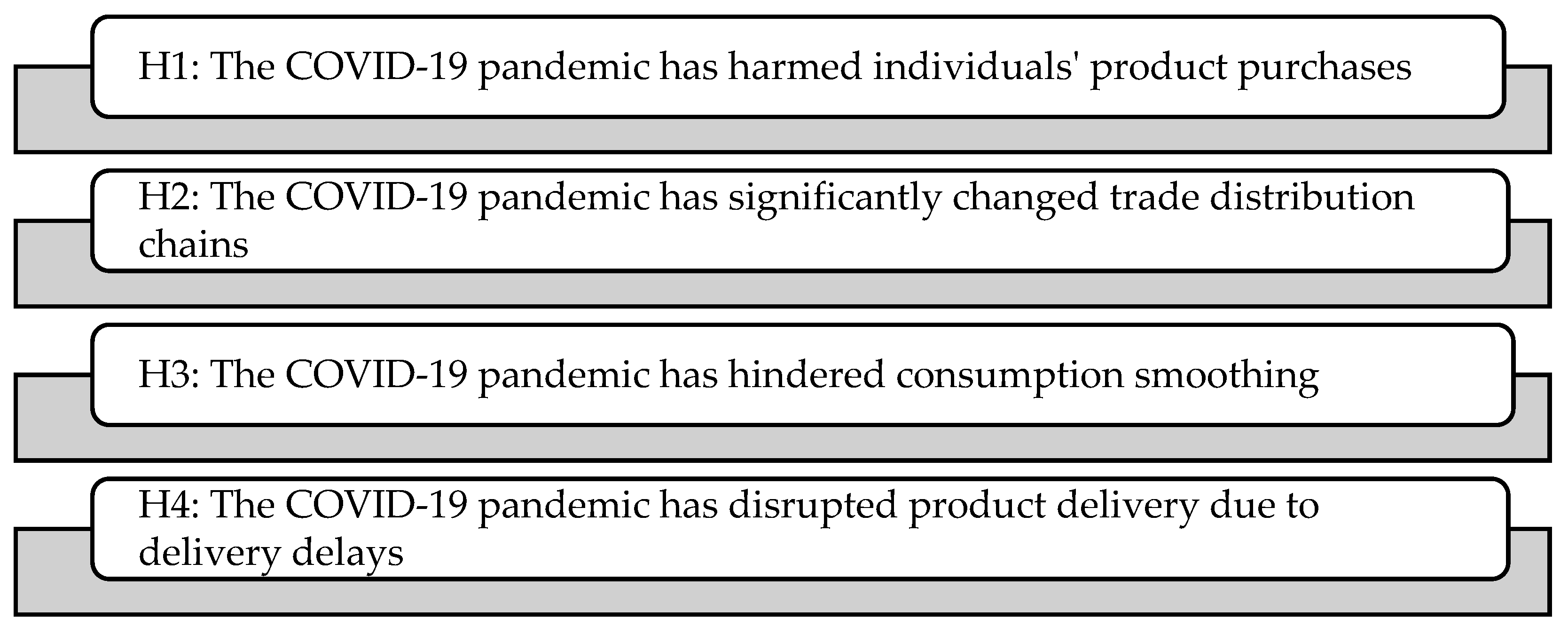
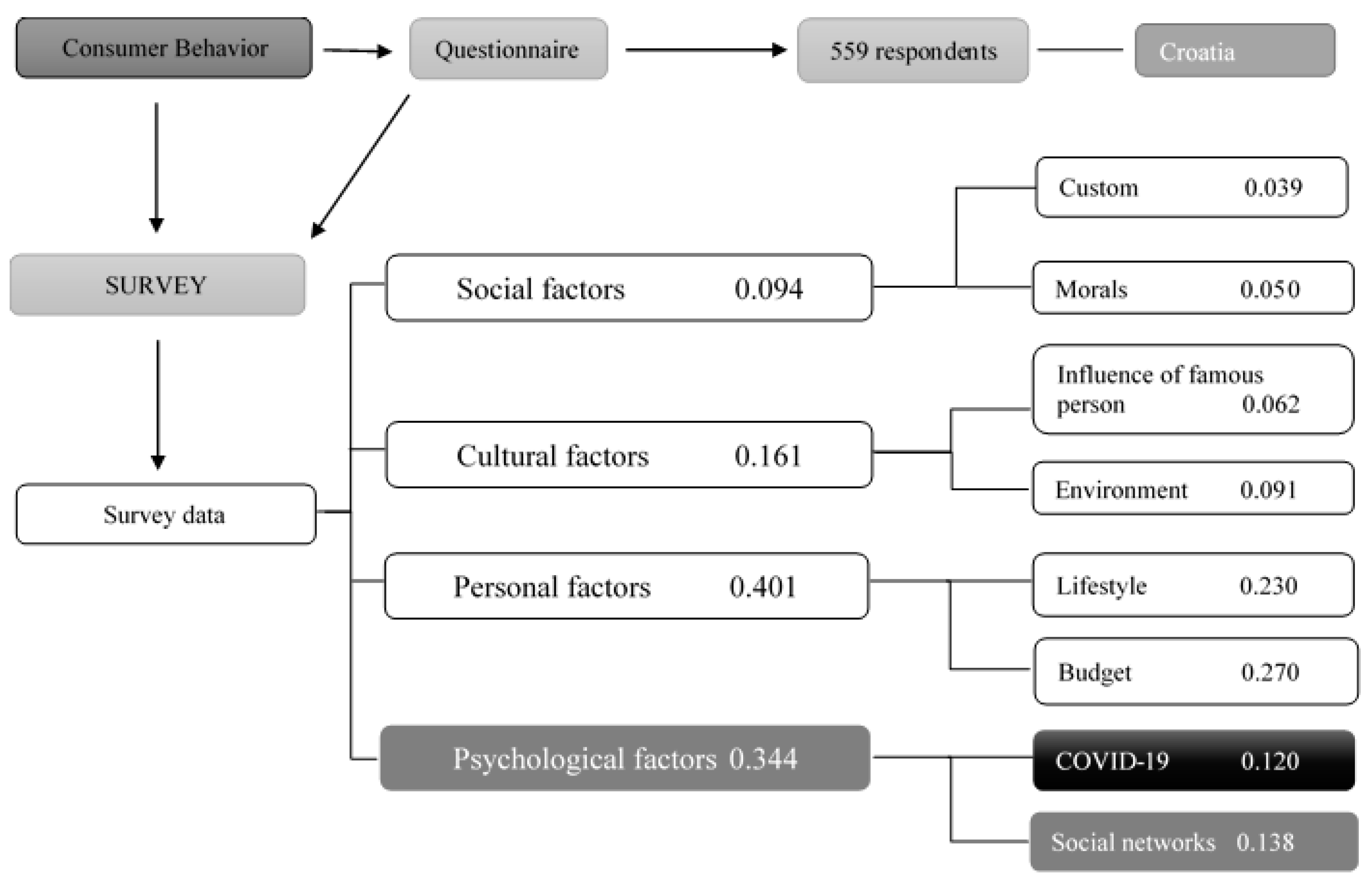
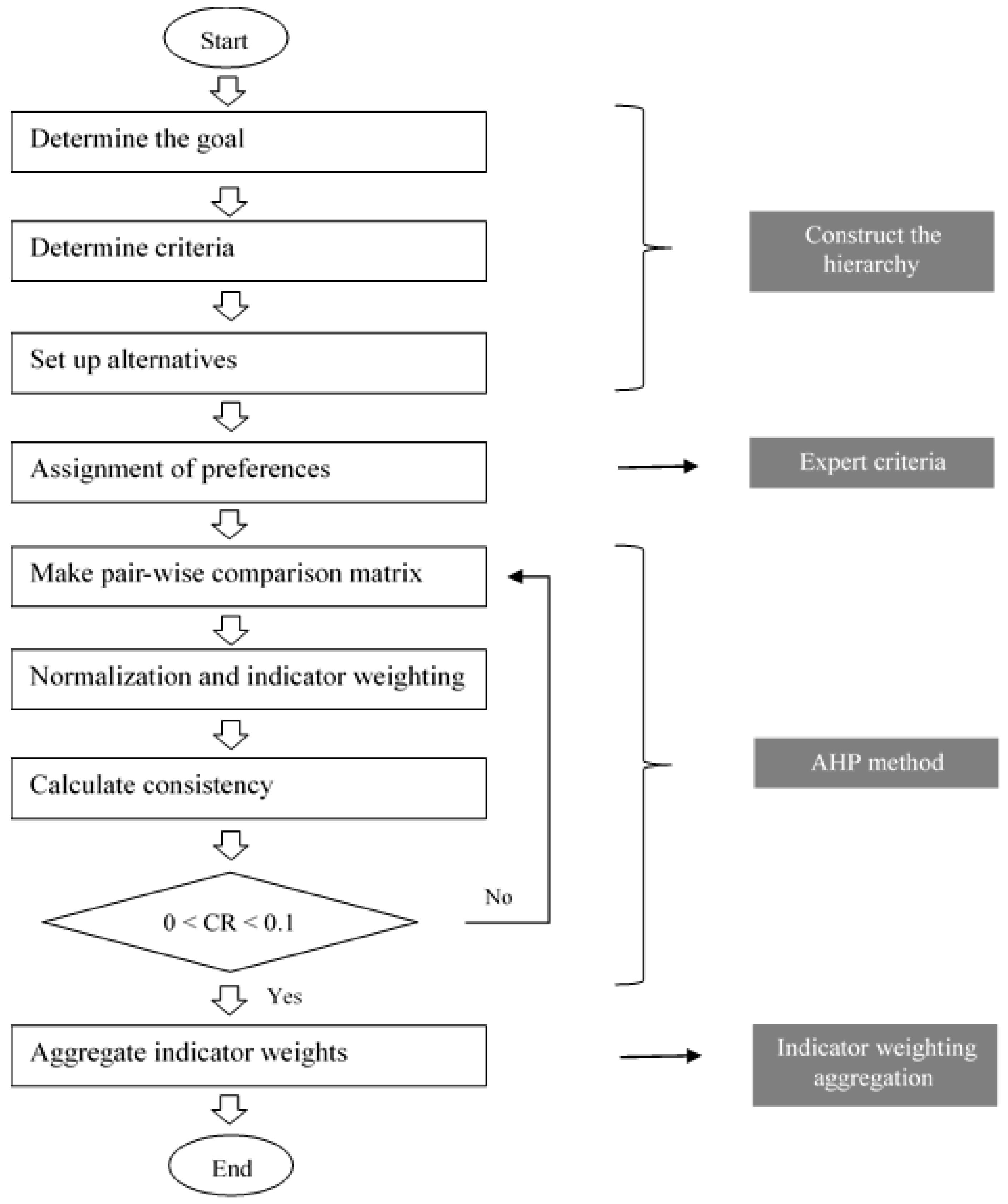
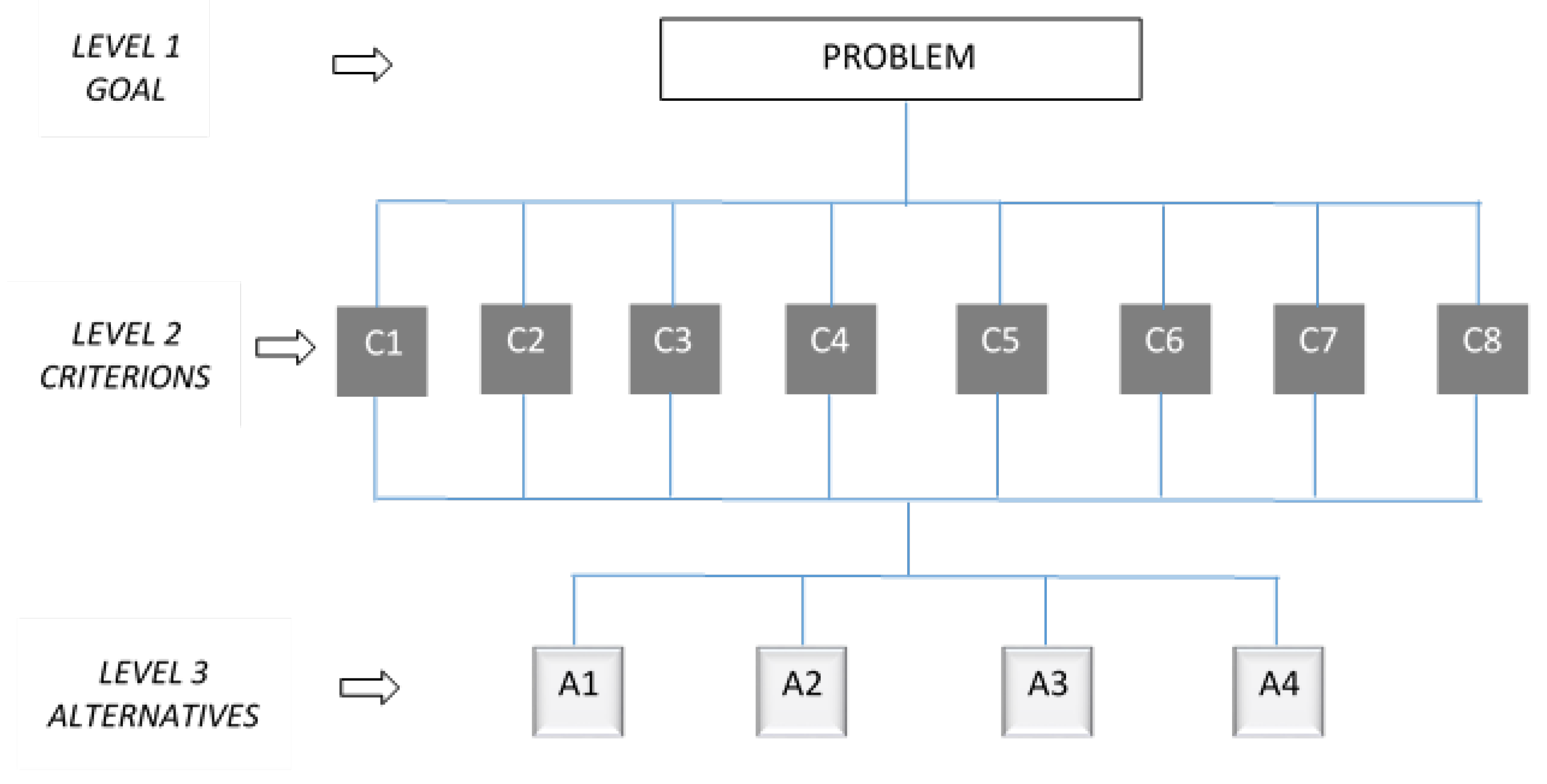

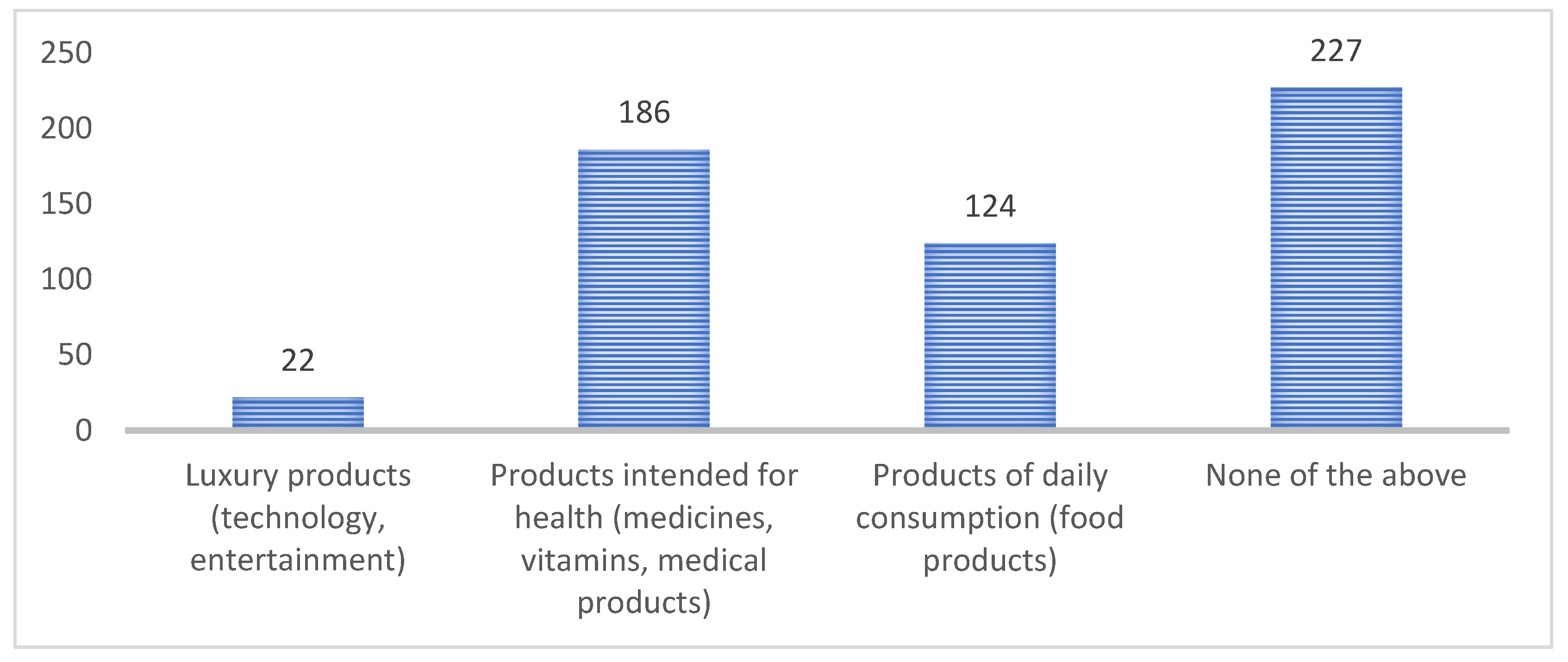
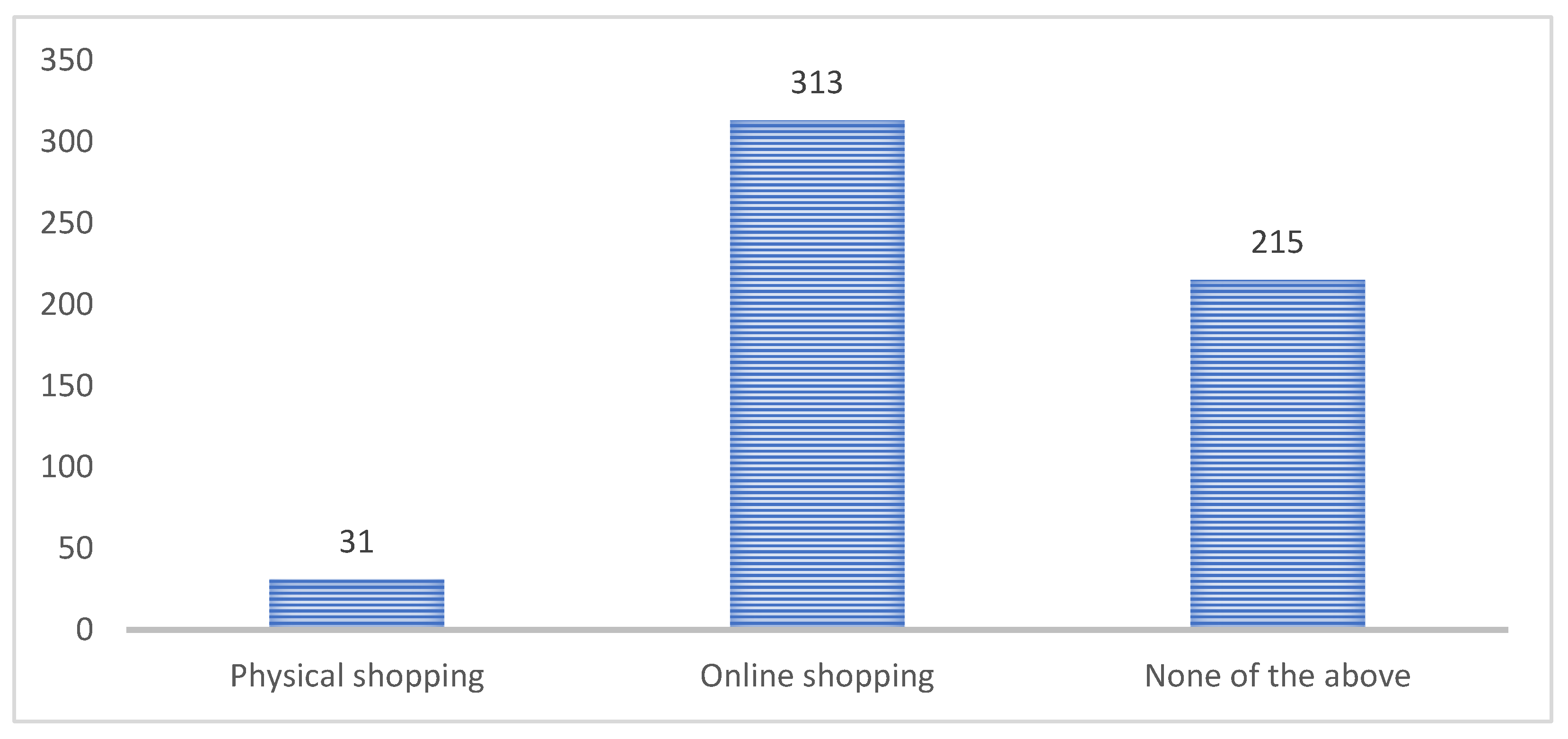
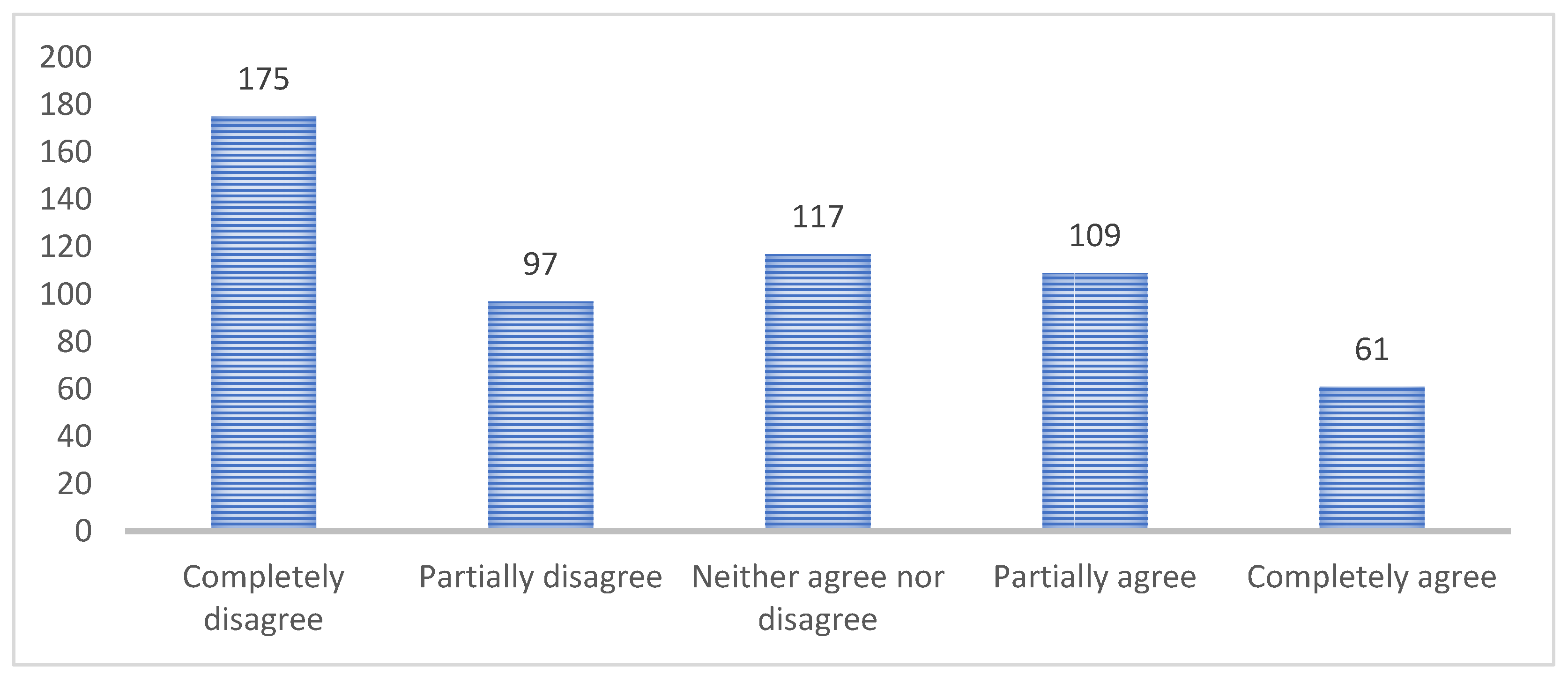
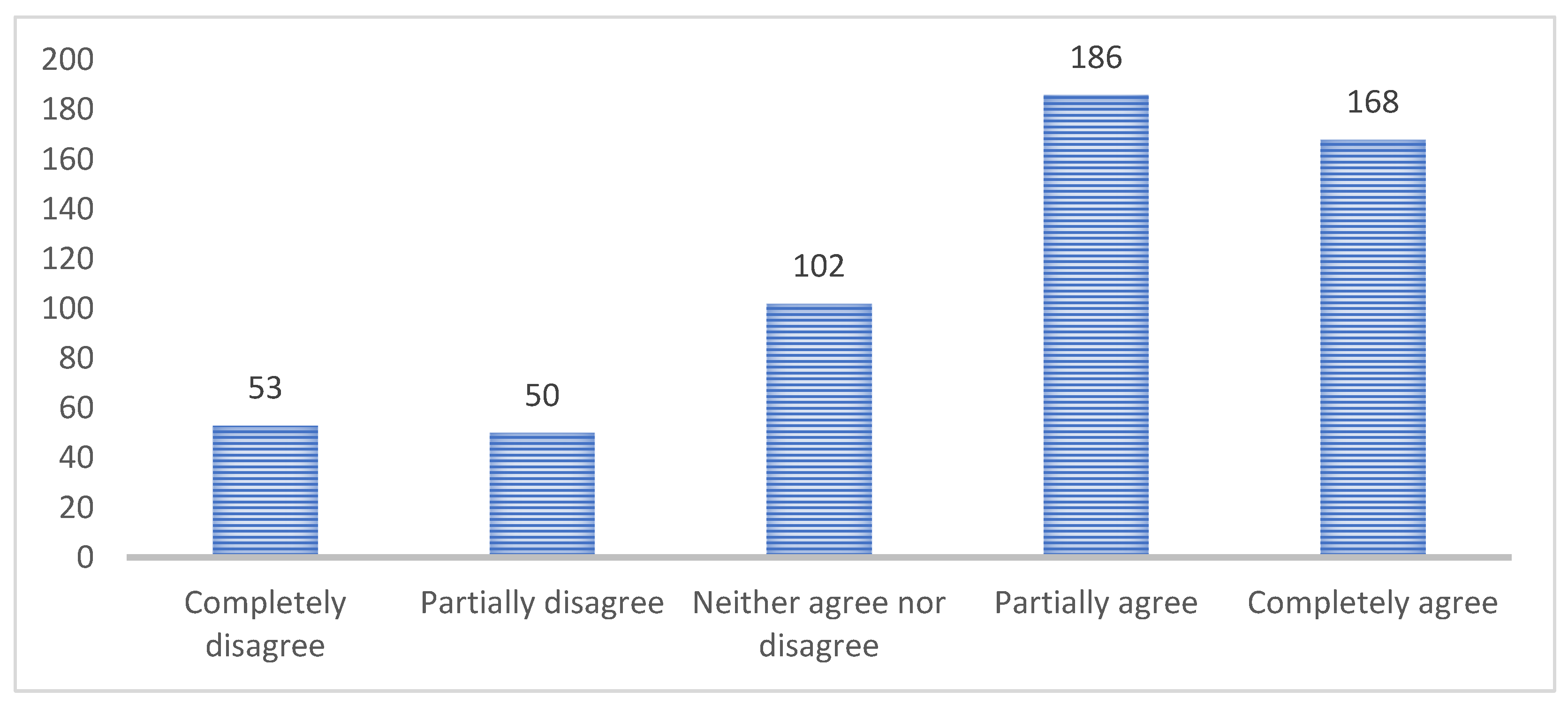
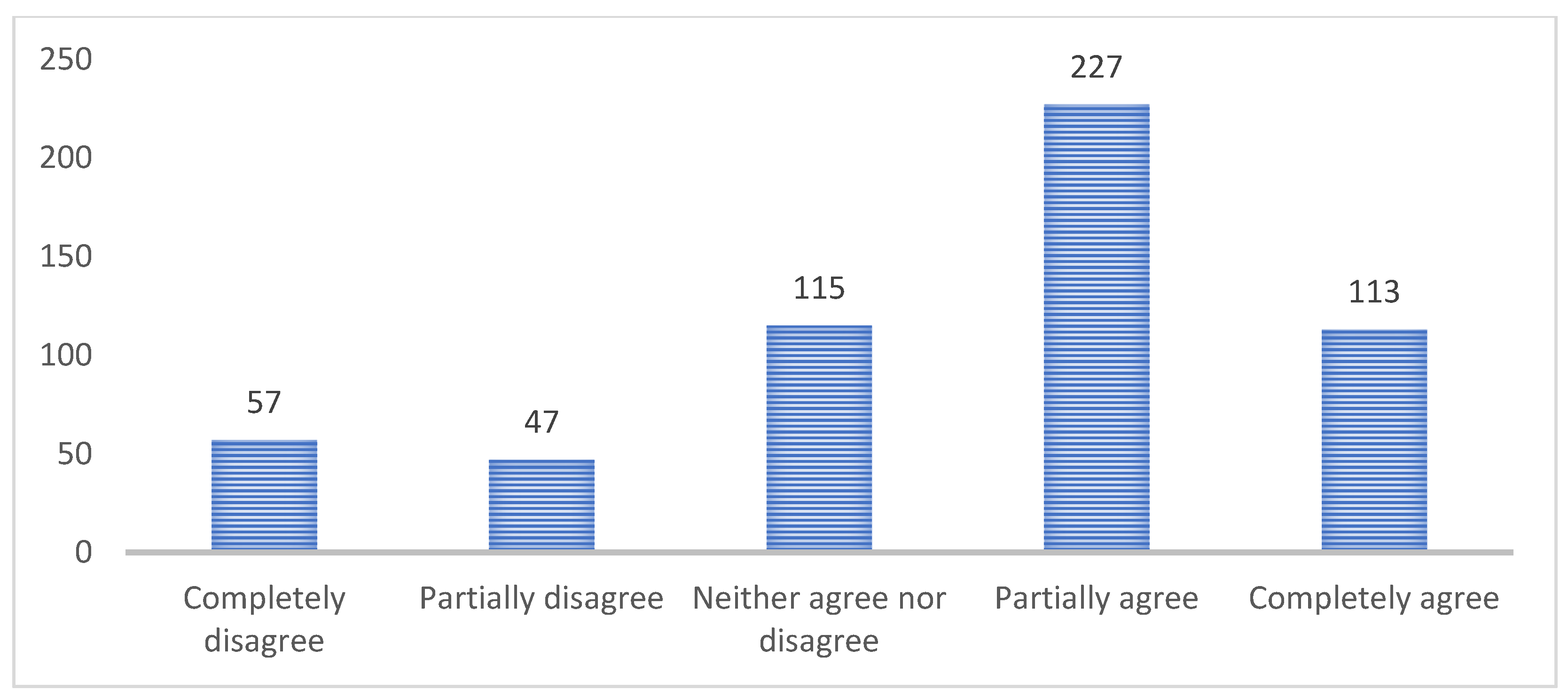
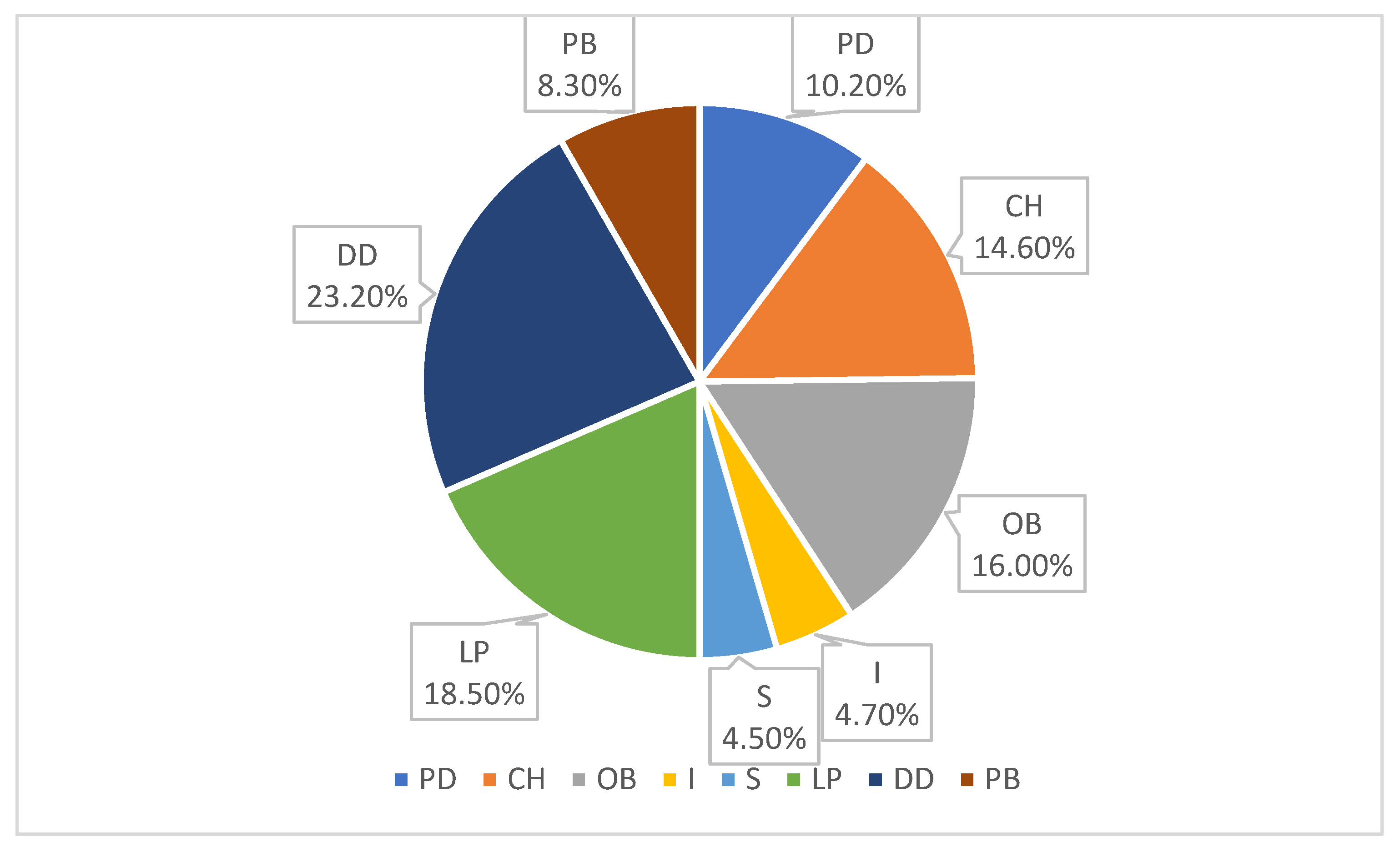
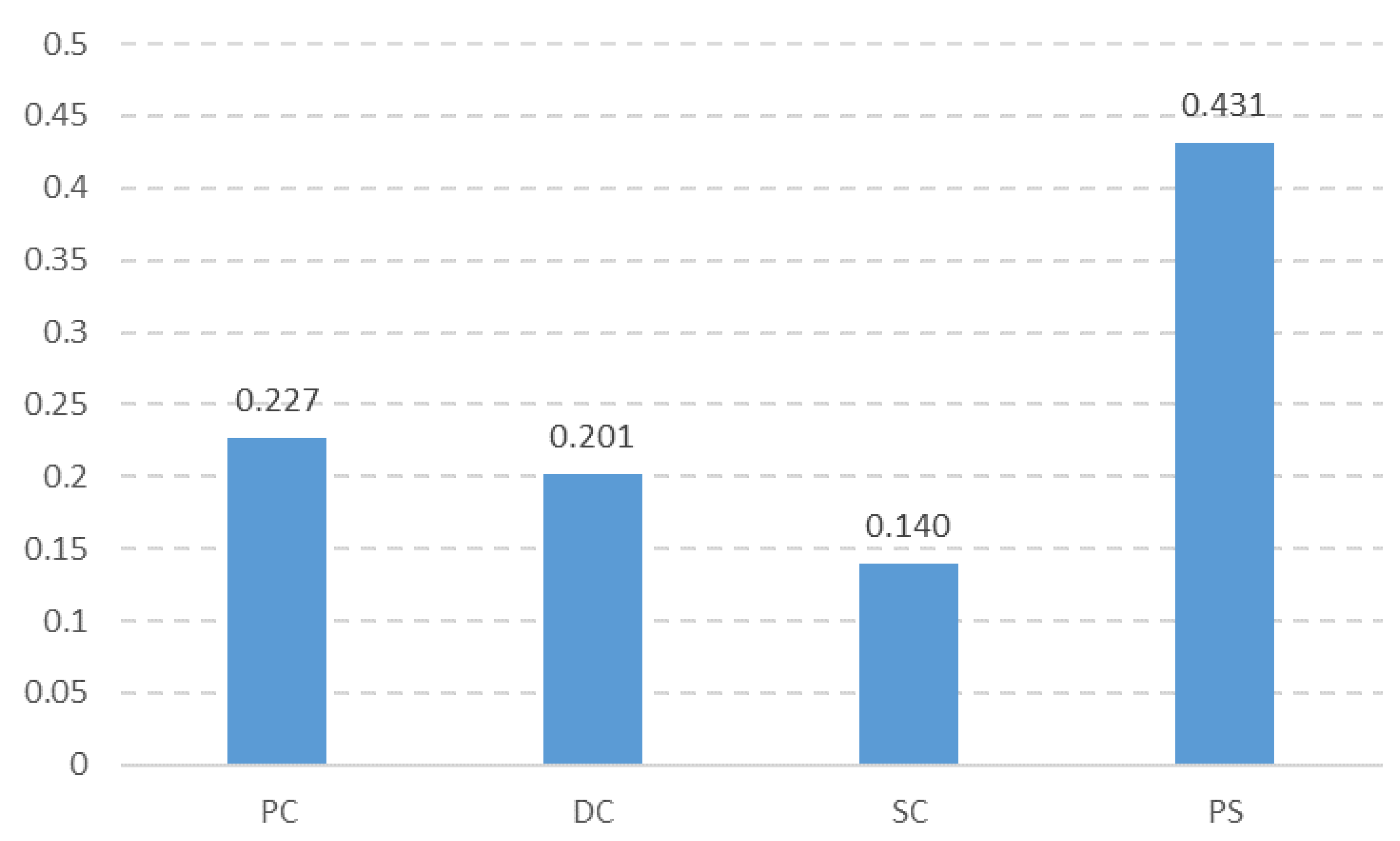
| Sex | No |
|---|---|
| Male | 201 |
| Female | 358 |
| Age range | No |
| 18 to 25 | 134 |
| 26 to 35 | 117 |
| 36 to 45 | 173 |
| 46 to 55 | 79 |
| Older than 56 | 56 |
| Occupation or Job status | No |
| Jobless | 148 |
| Employed | 411 |
| Relationship status | No |
| Not married | 241 |
| Married | 318 |
| Monthly earnings | No |
| Max 499 euro | 127 |
| 500 to 799 euro | 83 |
| 800 to 1099 euro | 153 |
| More than 1099 euro | 196 |
| Sex | Age | Job Status | Relationship Status | Monthly Earnings | |
|---|---|---|---|---|---|
| Mean | 279.5 | 111.8 | 279.5 | 279.5 | 139.8 |
| Standard Error | 78.5 | 20.6 | 131.5 | 38.5 | 23.7 |
| Median | 279.5 | 117 | 279.5 | 279.5 | 140 |
| Standard Deviation | 111.0 | 46.0 | 186.0 | 54.4 | 47.3 |
| Sample Variance | 12324.5 | 2113.7 | 34584.5 | 2964.5 | 2240.9 |
| Range | 157 | 117 | 263 | 77 | 113 |
| Minimum | 201 | 56 | 148 | 241 | 83 |
| Maximum | 358 | 173 | 411 | 318 | 196 |
| Sum | 559 | 559 | 559 | 559 | 559 |
| Count | 2 | 5 | 2 | 2 | 4 |
| Confidence level (95%) | 997.4 | 57.1 | 1670.9 | 489.2 | 75.3 |
| n | 1 | 2 | 3 | 4 | 5 | 6 | 7 | 8 | 9 | 10 | 11 | 12 | 13 | 14 |
| RI | 0 | 0 | 0.58 | 0.89 | 1.11 | 1.25 | 1.35 | 1.40 | 1.45 | 1.49 | 1.51 | 1.48 | 1.56 | 1.57 |
| Alternatives/Criteria | PD | CH | OB | I | S | LP | DD | PB |
|---|---|---|---|---|---|---|---|---|
| PC | 0.387 | 0.269 | 0.237 | 0.248 | 0.177 | 0.168 | 0.264 | 0.275 |
| DC | 0.198 | 0.222 | 0.173 | 0.195 | 0.140 | 0.231 | 0.183 | 0.198 |
| SC | 0.140 | 0.128 | 0.138 | 0.137 | 0.264 | 0.117 | 0.139 | 0.140 |
| PS | 0.275 | 0.381 | 0.452 | 0.419 | 0.419 | 0.484 | 0.481 | 0.387 |
| MATRIX | ||||||||
|---|---|---|---|---|---|---|---|---|
| V1 | V2 | V3 | V4 | V5 | V6 | V7 | V8 | |
| λmax | 4.12 | 4.22 | 4.12 | 4.22 | 4.14 | 4.12 | 4.22 | 4.12 |
| RI | 0.9 | 0.9 | 0.9 | 0.9 | 0.9 | 0.9 | 0.9 | 0.9 |
| CI | 0.04 | 0.07 | 0.04 | 0.07 | 0.05 | 0.04 | 0.07 | 0.04 |
| CR | 0.05 | 0.08 | 0.04 | 0.08 | 0.05 | 0.05 | 0.08 | 0.05 |
| PD | CH | OB | I | S | LP | DD | PB | Priorities | Range | |
|---|---|---|---|---|---|---|---|---|---|---|
| PC | 0.03 | 0.04 | 0.03 | 0.01 | 0.01 | 0.03 | 0.04 | 0.02 | 0.20 | 3 |
| DC | 0.02 | 0.03 | 0.05 | 0.01 | 0.01 | 0.05 | 0.06 | 0.01 | 0.23 | 2 |
| SC | 0.01 | 0.02 | 0.02 | 0.01 | 0.01 | 0.02 | 0.03 | 0.01 | 0.14 | 4 |
| PS | 0.04 | 0.06 | 0.06 | 0.02 | 0.02 | 0.08 | 0.10 | 0.04 | 0.42 | 1 |
| Weight vector | (0.10) | (0.15) | (0.16) | (0.05) | (0.05) | (0.19) | (0.23) | (0.08) | 1.00 | |
| rang | 5 | 4 | 3 | 7 | 8 | 2 | 1 | 6 |
Disclaimer/Publisher’s Note: The statements, opinions and data contained in all publications are solely those of the individual author(s) and contributor(s) and not of MDPI and/or the editor(s). MDPI and/or the editor(s) disclaim responsibility for any injury to people or property resulting from any ideas, methods, instructions or products referred to in the content. |
© 2023 by the authors. Licensee MDPI, Basel, Switzerland. This article is an open access article distributed under the terms and conditions of the Creative Commons Attribution (CC BY) license (https://creativecommons.org/licenses/by/4.0/).
Share and Cite
Šostar, M.; Ristanović, V. An Assessment of the Impact of the COVID-19 Pandemic on Consumer Behavior Using the Analytic Hierarchy Process Model. Sustainability 2023, 15, 15104. https://doi.org/10.3390/su152015104
Šostar M, Ristanović V. An Assessment of the Impact of the COVID-19 Pandemic on Consumer Behavior Using the Analytic Hierarchy Process Model. Sustainability. 2023; 15(20):15104. https://doi.org/10.3390/su152015104
Chicago/Turabian StyleŠostar, Marko, and Vladimir Ristanović. 2023. "An Assessment of the Impact of the COVID-19 Pandemic on Consumer Behavior Using the Analytic Hierarchy Process Model" Sustainability 15, no. 20: 15104. https://doi.org/10.3390/su152015104
APA StyleŠostar, M., & Ristanović, V. (2023). An Assessment of the Impact of the COVID-19 Pandemic on Consumer Behavior Using the Analytic Hierarchy Process Model. Sustainability, 15(20), 15104. https://doi.org/10.3390/su152015104







